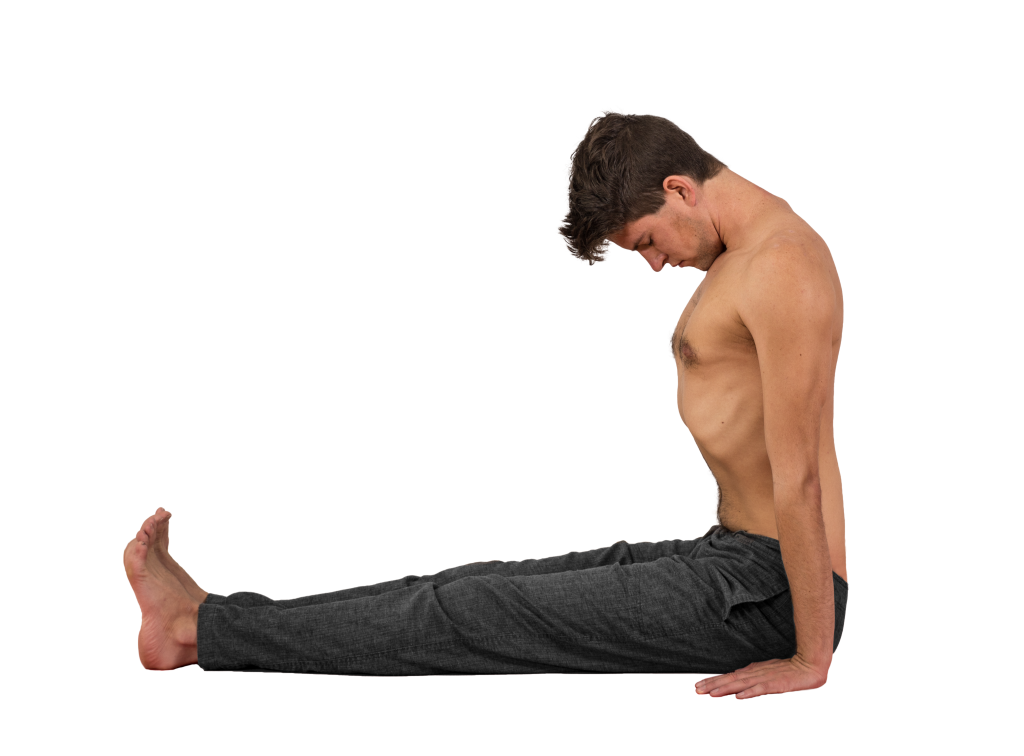Dandasana
- Danda: Staff / Stick
- Asana: Pose
Dandasana is the sixth pose of the primary series, and the first seated pose.
Dandasana is performed before each seated posture as part of the vinyasa to seated. As part of the vinyasa to Paschimottanasana, it is performed for five breaths. As part of the vinyasa to other seated poses, it is not held.
Focus On…
This pose establishes the blueprint for all forward folds and teaches the principles of forward folding that will be revisited frequently during the primary series. For those well established in the method of forward fold alignment, it provides a moment of introspection and an opportunity to commune with the bandha.
Principles of Forward Folding:
- Fold, don’t curl. Ideally, a forward fold is a very shallow flexion, rather than a deep rounding of the spine. Forward folding is like folding a piece of paper: rather than head-to-knees, the belly comes down first, the ribs follow, then the head last.
- The movement of forward folds comes from the hips. Specifically, from an anterior tilt of the pelvis. The hips move first, and the ribs and head follow along, similar to the movement of a whip. If you slump into a forward fold, or move from the upper body, you are wasting your time.
- Keep strong, active hamstrings: dig/drag the heels down into the mat so there’s a sense of strength and depth at the backs of the knees.Draw the sitting bones together. Spread the toes and press through the root of the big toe. Flaccid legs and pelvic floor greatly increase risk of injury.
- Internally rotate the thighbones. If only one leg is straight, as in the asymmetrical postures, internally rotate that leg.
- Do not clench the abdominal muscles. The belly ought to be long and soft, with a sense of hollowing, or the belly falling back against the spine. Engaging the rectus abdominus shortens the torso, restricts movement, and places potentially harmful pressure on the spine.
- Pull the shoulders back, and broaden the chest. Keep the collarbones long and the shoulders back for the entire duration of the asana.
These principles are common to all forward folds. Each forward fold also has its own distinguishing actions and characteristics.
In Dandasana, the arms are straight and the hands press into the floor alongside the hips. The spine is fully vertical, and the chin comes to rest on the manubrium, between the collarbones. If your neck doesn’t allow for this much movement, don’t open your mouth to try and touch chin and chest, just be patient.
This pose, though simple in appearance, is not a chance to relax. Every part of the body is effortful.
Vinyasa of the Pose
Transition to seated, exhaling.
Inhale, and press the hands into the floor, sitting fully upright and working the actions of forward folding as described above. This is the state of the pose; spend five breaths here.

Exhale, and release. Transition directly to Paschimottanasana.
Alternatives & Solutions
If the hamstrings feel quite tight, or if you’re unable to sit up straight (the spine is rounding), place a blanket or block beneath the hips. Add additional support if necessary until both the legs and spine can be straightened.
Common Mistakes
Do not allow yourself to slump, or the pelvis to rotate posteriorly. Do not be hasty here; be sure you take the time to figure out the workings of this pose before you move on to other forward folds.


I am finding so much values I all these in depth anatomical descriptions. Thank you so much for this valuable service you have provided!
Thanks, Tim!
I love your blog. It is very illuminating. Thank you!